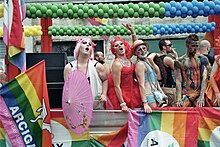| History of Italy |
|---|
 |
This article is about lesbian, gay, bisexual and transgender (LGBT) history in Italy.
| History of Italy |
|---|
 |
This article is about lesbian, gay, bisexual and transgender (LGBT) history in Italy.

Romans, like Greeks, tolerated love and sex among men. Two Roman Emperors publicly married men, some had gay lovers themselves, and homosexual prostitution was taxed. However, like the Greeks, passivity and effeminacy were not tolerated, and an adult male freeborn Roman could lose his citizen status if caught performing fellatio or being penetrated. [6]








Societal attitudes towards same-sex relationships have varied over time and place. Attitudes to male homosexuality have varied from requiring males to engage in same-sex relationships to casual integration, through acceptance, to seeing the practice as a minor sin, repressing it through law enforcement and judicial mechanisms, and to proscribing it under penalty of death. In addition, it has varied as to whether any negative attitudes towards men who have sex with men have extended to all participants, as has been common in Abrahamic religions, or only to passive (penetrated) participants, as was common in Ancient Greece and Ancient Rome. Female homosexuality has historically been given less acknowledgment, explicit acceptance, and opposition.

Societal attitudes toward homosexuality vary greatly across different cultures and historical periods, as do attitudes toward sexual desire, activity and relationships in general. All cultures have their own values regarding appropriate and inappropriate sexuality; some sanction same-sex love and sexuality, while others may disapprove of such activities in part. As with heterosexual behaviour, different sets of prescriptions and proscriptions may be given to individuals according to their gender, age, social status or social class.

Records of men who have sex with men in Japan date back to ancient times. Western scholars have identified these as evidence of homosexuality in Japan. Though these relations had existed in Japan for millennia, they became most apparent to scholars during the Tokugawa period. Historical practices identified by scholars as homosexual include shudō (衆道), wakashudō (若衆道) and nanshoku (男色).

The following is the timeline of lesbian, gay, bisexual, and transgender (LGBT) history.

LGBT history dates back to the first recorded instances of same-sex love and sexuality of ancient civilizations, involving the history of lesbian, gay, bisexual, and transgender (LGBT) peoples and cultures around the world. What survives after many centuries of persecution—resulting in shame, suppression, and secrecy—has only in more recent decades been pursued and interwoven into more mainstream historical narratives.
Christian leaders have written about male homosexual activities since the first decades of Christianity; female homosexual behavior was almost entirely ignored. Throughout the majority of Christian history, most Christian theologians and denominations have considered homosexual behavior as immoral or sinful.

Lesbian, gay, bisexual, and transgender (LGBT) rights in Spain rank among the highest in the world, having undergone significant advancements within recent decades. Among ancient Romans in Spain, sexual interaction between men was viewed as commonplace, but a law against homosexuality was promulgated by Christian emperors Constantius II and Constans, and Roman moral norms underwent significant changes leading up to the 4th century. Laws against sodomy were later established during the legislative period. They were first repealed from the Spanish Code in 1822, but changed again along with societal attitudes towards homosexuality during the Spanish Civil War and Francisco Franco's regime.

Franco Grillini is an Italian politician and a prominent Italian gay-rights activist. His story is inextricably linked to the history of Arcigay.

Homosexuality in ancient Rome often differs markedly from the contemporary West. Latin lacks words that would precisely translate "homosexual" and "heterosexual". The primary dichotomy of ancient Roman sexuality was active / dominant / masculine and passive / submissive / feminine. Roman society was patriarchal, and the freeborn male citizen possessed political liberty (libertas) and the right to rule both himself and his household (familia). "Virtue" (virtus) was seen as an active quality through which a man (vir) defined himself. The conquest mentality and "cult of virility" shaped same-sex relations. Roman men were free to enjoy sex with other males without a perceived loss of masculinity or social status as long as they took the dominant or penetrative role. Acceptable male partners were slaves and former slaves, prostitutes, and entertainers, whose lifestyle placed them in the nebulous social realm of infamia, so they were excluded from the normal protections accorded to a citizen even if they were technically free. Freeborn male minors were off limits at certain periods in Rome.
This is a history of same-sex unions in cultures around the world. Various types of same-sex unions have existed, ranging from informal, unsanctioned, and temporary relationships to highly ritualized unions that have included marriage. State-recognized same-sex unions have recently become more widely accepted, with various countries recognizing same-sex marriages or other types of unions. A celebrated achievement in LGBT history occurred when Queen Beatrix signed a law making Netherlands the first country to legalize same-sex marriage.

Lesbian, gay, bisexual, and transgender (LGBT) people in Zimbabwe face legal challenges not experienced by non-LGBT residents. Since 1995, the Government of Zimbabwe has carried out campaigns against LGBT rights. Sodomy is classified as unlawful sexual conduct and defined in the Criminal Code as either anal sexual intercourse or any "indecent act" between consenting adults. Since 1995, the government has carried out campaigns against both homosexual men and women.

Lesbian, gay, bisexual, and transgender (LGBT) rights in Italy significantly advanced in the 21st century, although LGBT people still face various challenges not experienced by non-LGBT residents, despite public opinion being increasingly liberal and in favor of LGBT rights. According to ILGA-Europe's 2021 report, the status of LGBT rights in Italy is below the standards of other Western European countries – such as still not recognizing same-sex marriage, lacking nationwide discrimination protections for goods and services, as well as not granting to same-sex couples full parental rights, such as joint adoption and IVF. Italy and Japan are the only G7 nations where same-sex marriages are not permitted.

Lesbian, gay, bisexual, and transgender (LGBT) people in San Marino may face legal challenges not experienced by non-LGBT residents. Both male and female same-sex sexual activity are legal in San Marino, but households headed by same-sex couples are not eligible for the same legal protections available to opposite-sex couples.

The legal code regarding lesbian, gay, bisexual, and transgender (LGBT) rights in Vatican City is based on the Italian Zanardelli Code of 1889, since the founding of the sovereign state of the Vatican City in 1929.

This is a list of important events relating to the LGBT community from 1801 to 1900. The earliest published studies of lesbian activity were written in the early 19th century.

A sodomy law is a law that defines certain sexual acts as crimes. The precise sexual acts meant by the term sodomy are rarely spelled out in the law, but are typically understood and defined by many courts and jurisdictions to include any or all forms of sexual acts that are illegal, illicit, unlawful, unnatural and immoral. Sodomy typically includes anal sex, oral sex, manual sex, and bestiality. In practice, sodomy laws have rarely been enforced to target against sexual activities between individuals of the opposite sex, and have mostly been used to target against sexual activities between individuals of the same sex.
The history of lesbian, gay, and bisexual people in China spans thousands of years. Unlike the histories of European and European-ruled polities in which Christianity formed the core of heavily anti-LGBT laws until recent times, non-heterosexual states of being were historically treated with far less animosity in Chinese states. For a period of the modern history of both the Republic of China and People's Republic of China in the 20th century, LGBT people received more stringent legal regulations regarding their orientations, with restrictions being gradually eased by the beginning of the 21st century. However, activism for LGBT rights in both countries has been slow in development due to societal sentiment and government inaction.
In medieval Europe, attitudes toward homosexuality varied from region to region, determined by religious culture; the Catholic Church, which dominated the religious landscape, considered, and still considers, sodomy as a mortal sin and a "crime against nature". By the 11th century, "sodomy" was increasingly viewed as a serious moral crime and punishable by mutilation or death. Medieval records reflect this growing concern. The emergence of heretical groups, such as the Cathars and Waldensians, witnesses a rise in allegations of unnatural sexual conduct against such heretics as part of the war against heresy in Christendom. Accusations of sodomy and "unnatural acts" were levelled against the Order of the Knights Templar in 1307 as part of Philip IV of France's attempt to suppress the order. These allegations have been dismissed by some scholars.

Capital punishment as a criminal punishment for homosexuality has been implemented by a number of countries in their history. It is a legal punishment in several countries and regions, all of which have sharia-based criminal laws, except for Uganda.
The Christian tradition has generally proscribed any and all noncoital genital activities, whether engaged in by couples or individuals, regardless of whether they were of the same or different sex. The position of the Roman Catholic Church with regards to homosexuality developed from the writings of Paul the Apostle and the teachings of the Church Fathers. These were in stark contrast to contemporary Greek and Roman attitudes towards same-sex relations which were more relaxed.
They encircle two other bird-masked men, both with erect penises. Parallel lines connect the neck to the buttocks and ankles and the penis of one man to the buttocks of another. Thought by most scholars to be a sacrificial rite in which the parallel lines represent bindings, other interpreters see this as a homoerotic initiatory rite, with the lines possibly representing male energy, or even ejaculation.
Elagabalus is also alleged to have appeared as Venus and to have depilated his entire body. ... Dio recounts an exchange between Elagabalus and the well-endowed Aurelius Zoticus: when Zoticus addressed the emperor as 'my lord,' Elagabalus responded, 'Don't call me lord, I am a lady.' Dio concludes his anecdote by having Elagabalus asking his physicians to give him the equivalent of a woman's vagina by means of a surgical incision.